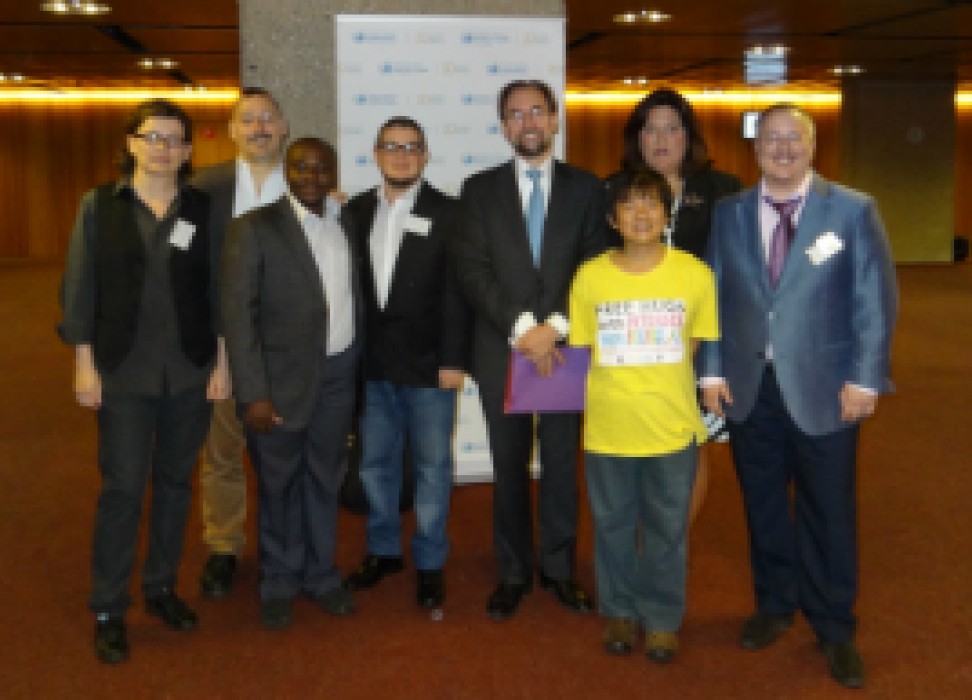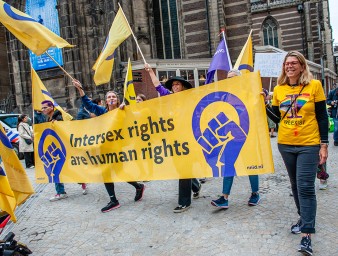A step forward for intersex visibility and human rights
25 September 2015

Not every child who is born fits the typical definition of either a boy or a girl. Daniela Truffer was born with ambiguous genitalia in which an infant's external genitals don't appear to be clearly male or female.
“When I was born, they couldn’t tell if I was a boy or a girl. They castrated me at two months and mutilated my genitals at seven,” said Truffer, an intersex activist at the international NGO Zwischengeschlecht.org. She always felt she was lied to by the medical community. “They said I had ovaries, but I had testes. You feel shame. You have to hide and you don’t know why,” she said. Truffer has dedicated her life as an activist to fighting for a legal ban on medically unnecessary surgeries and treatment on intersex children without consent, in order to prevent others from going through severe pain and suffering like she did.
Intersex persons are born with a wide range of natural variations in their sex characteristics that don’t fit the typical definition of male or female, including sexual anatomy, reproductive organs or chromosome patterns. It’s estimated that up to 1.7 per cent of the population is born with intersex traits. Intersex people, in addition to facing medically unnecessary surgeries and treatment without consent, also often face stigma and discrimination.
Truffer participated at a meeting organized by the UN Human Rights Office aimed to specifically address the human rights situation of intersex persons. The two-day conference was the first of its kind for the United Nations. The meeting in Geneva, Switzerland brought together experts from UN and regional human rights mechanisms, intersex civil society organizations and experts to reflect on recent developments in the protection of the rights of intersex people at the UN, regional and national level and to identify the current challenges and gaps in addressing human rights violations faced by intersex people.
During his opening remarks, UN High Commissioner for Human Rights Zeid Ra’ad Al Hussein admitted that when he started as High Commissioner a year ago, he knew little about intersex people – a reflection of a general lack of awareness.
“Too many people assume, without really thinking about it, that everyone can be fitted into two distinct and mutually exclusive categories,” Zeid said. “But in fact, human beings – like most living beings – are more diverse and complex than that. Our diversity – the differences between our experiences and perspectives, as well as the shapes of our bodies – is something that we should celebrate and protect, in all its forms.”
Kimberly Zieselman, Executive Director of Advocates for Informed Choice, didn’t find out the truth about being intersex until she was 41-years-old. But, all of her life she had a profound sense that something was different about her. “I felt free when I found out,” she said. She said this meeting gave her an opportunity to share her experience with other intersex people and with UN and regional organizations and that it was an historic moment for the intersex community. “Intersex has arrived, but the hard work lies ahead,” she said.
The myth that people belong to one of two distinct and separate sexes is what contributes to the stigma and discrimination felt by the intersex community. The human rights violations linked to this stigma include medically unnecessary surgeries and other invasive treatment of intersex babies and children without consent, which have been condemned as harmful practices and ill treatment by UN bodies, as well as infanticides of intersex babies; and widespread and life-long discrimination, including in education, employment, health, sports, accessing public services, birth registration and obtaining identity documents.
“Such violations are rarely discussed and even more rarely investigated or prosecuted,” Zeid said. “The result is impunity for the perpetrators; lack of remedy for victims; and a perpetuating cycle of ignorance and abuse.”
Dan Christian Ghattas, from Organisation Intersex International Europe, expressed how difficult it was for him in school as an intersex person. “If you don’t exist, you’re discriminated against,” he said. “At school, they talk about boys and girls, so you don’t fit in. You’re not learning about your kind of people, besides showing up in biology books as a malformation, so you are not acknowledged. This discrimination is traumatizing and impacts on your life.”
Zeid noted there is progress being made in advancing the rights of intersex people due to the tireless work of intersex organizations and human rights defenders. Zeid also added that there have been recommendations urging member States to take steps to address these violations and that in some States there have recently been some important court judgments and new laws to protect the rights of intersex people.
However, he also stressed that more work needs to be done to raise awareness and prevent violations. “We need to bridge the gap between legislation and the lived realities of intersex people,” he said.
